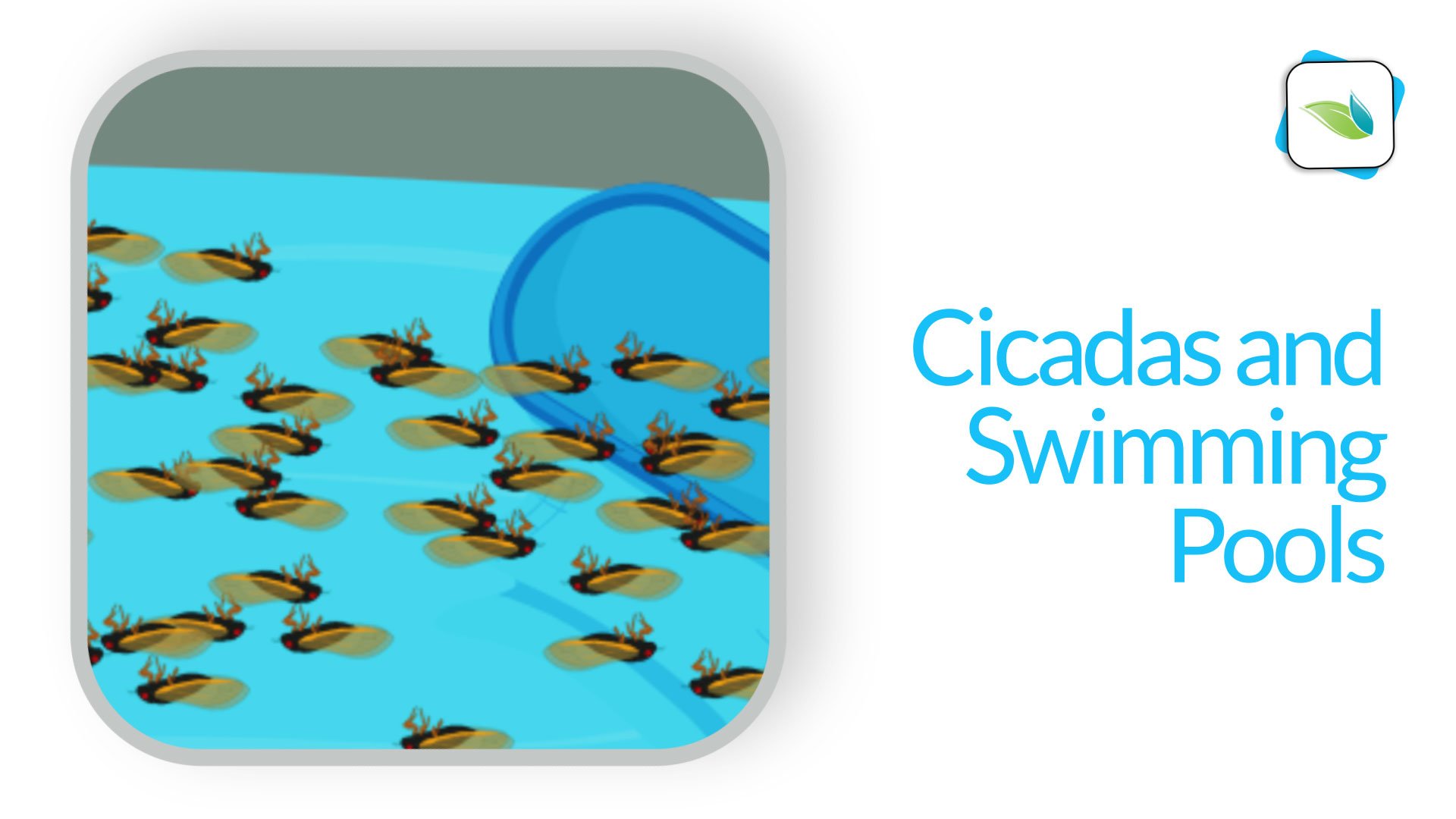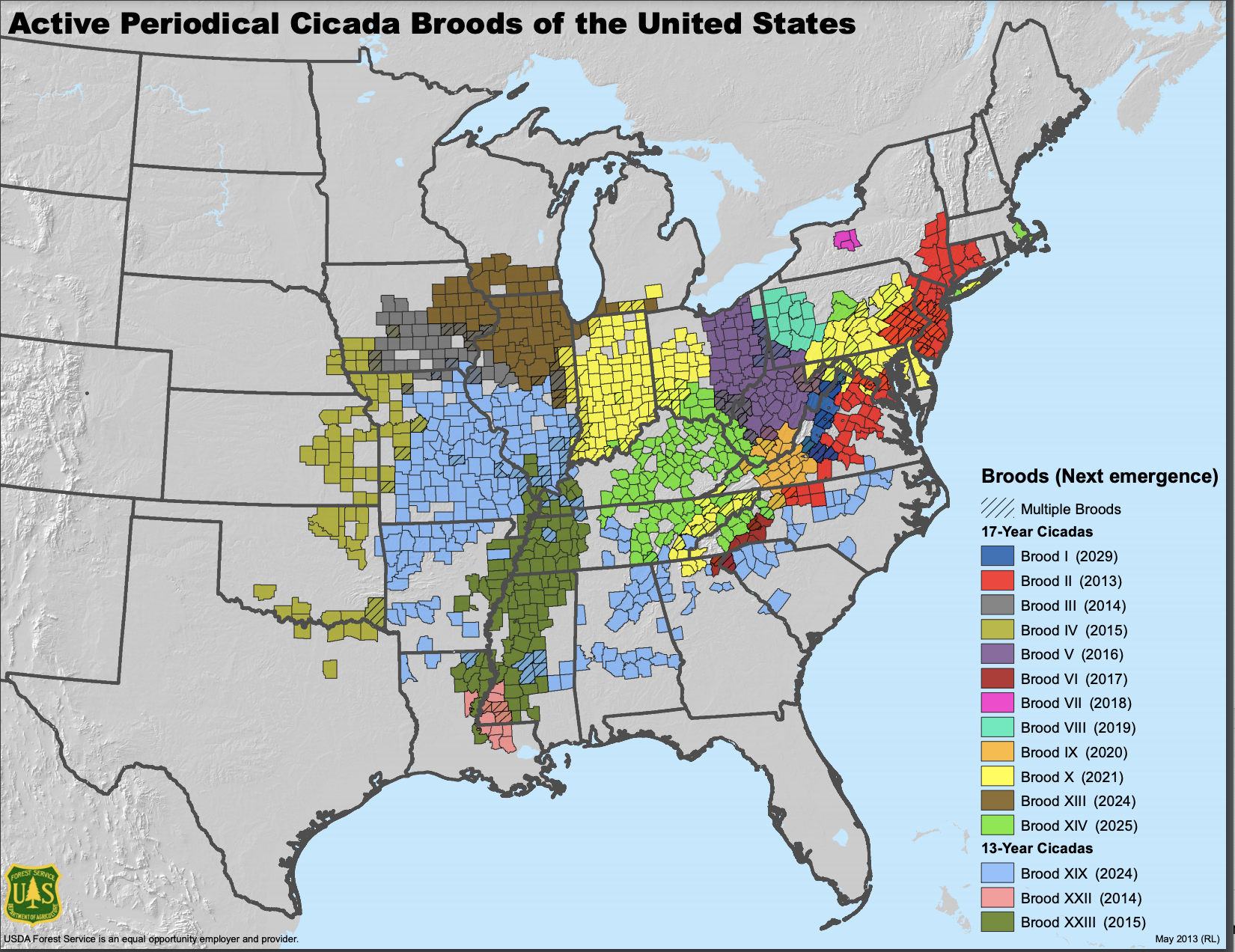Cicadas and Swimming Pools

In much of the world, cicadas emerge every 13 or 17 years. And while cicadas are not born to be swimmers, their sheer numbers will lead to many landing (and dying) in pools. Let's discuss how to handle these giant insects.
Covered in this article:
- What are cicadas?
- Periodic cicada emergence and temporary invasion
- Cicadas only live 2-6 weeks after emerging
- Cicadas and swimming pools
- Cicadas pee. A lot.
- The aftermath
What are cicadas?

Cicadas are large insects that live on 13 or 17 year life cycles. They emerge, climb or fly up trees, mate, lay eggs, and die shortly after (....what a life).
The eggs are embedded in tree branches and eventually fall to the ground, where the baby cicada nymphs burrow down several feet. Depending on the brood, they remain there for 13 or 17 years. This slow gestation period makes cicadas an interesting insect.
In their final year of growth, the cicadas instinctively awaken and climb up out of the ground when the ground temperature gets warm enough.1 In areas of the country with older, undisturbed soils (like forests and old neighborhoods), over one million cicadas can emerge from the ground per acre.
One million cicadas per acre. It's astounding. Thankfully, cicadas are harmless and do not sting.
According to biologists who study cicadas, their species survives by reproducing in overwhelming numbers. It's called "predator satiation". In other words, emerge in such numbers that predators cannot possibly eat them all.2 Almost every bird gorges on cicadas–as do cats, raccoons, opossums, snakes, frogs, and turtles. To these small predators, cicadas are an irresistible delicacy. And yet, they hardly make a dent in the cicada's numbers.
This overwhelming flood of cicadas every 13 or 17 years provides about 2-6 weeks of ear-splitting loud noise. It also gives other bugs and small prey a chance to reproduce while the predators are feasting on cicadas, allowing their populations to grow. It's all part of the circle of life.
Periodical cicada emergence and temporary invasion
One of the largest swarms of cicadas is called Brood X (brood ten). It's in the mid-Atlantic area, covering Northern Virginia, DC, Maryland, Pennsylvania, Delaware and New Jersey. Brood X is a 17-year species, and its population is impossible to count.
If you are in the eastern United States, you may remember the cicadas 2004 and 2021. The 2021 summer's cicada's parents were buzzing at ear-splitting volumes for weeks. They mated, then each female sliced into tree branches to lay hundreds of eggs. Those eggs hatched into Nymphs (estimated 1.4 million per acre). The nymphs dropped to the ground and burrowed deep underground for 17 years. In 2021, they made their return. And it was ....loud.
This every-seventeen-year phenomenon dates back to before Europeans arrived on this continent. In fact, they are mentioned in writing as far back as William Bradford, the first Governor of Massachusetts in 1633.3
Cicadas live only 2-6 weeks after emerging
After 17 years of darkness and slow development, cicadas emerge to do their thing. And within 2-6 weeks of emerging, they die. It's sad in a way, but it's their natural order. For us, this means cicada carcasses. Lots and lots of cicada carcasses.

Image Source: National Geographic

Image Source: United States Forest Service
Cicadas and swimming pools
 We must remember where cicadas have been in their short time above the ground. They have been in the trees (mostly). When females cut open small branches to lay their eggs, they get covered in tree sap. And while this is a minuscule amount of tree sap, keep in mind we're talking about over a million cicadas per acre. If you have hundreds of cicadas dropping into your pool, you can bet the non-living organic load will rise. Chlorine demand will temporarily rise too (at least until you remove them from the water).
We must remember where cicadas have been in their short time above the ground. They have been in the trees (mostly). When females cut open small branches to lay their eggs, they get covered in tree sap. And while this is a minuscule amount of tree sap, keep in mind we're talking about over a million cicadas per acre. If you have hundreds of cicadas dropping into your pool, you can bet the non-living organic load will rise. Chlorine demand will temporarily rise too (at least until you remove them from the water).
And according to one research study done at the University of Chicago, decomposing cicadas are rich in Carbon, Phosphorus, and Nitrogen.4 That study also found that cicada carcass decomposition rates––and subsequent release of nitrogen and phosphorus into the water––were much higher than the decomposition rate of sycamore leaves.
Cicadas pee. A lot.
Another fascinating (and hilarious) trait of cicadas is how much they urinate. To quote from an article in Scientific American Journal:
Cicadas consume copious amounts of watery plant fluid, which means that nature is constantly calling. But unlike most insects that flick away waste one droplet at a time, cicadas spray their pee out in high-speed streams reminiscent of the bathroom habits of mammals. According to a new paper published last week in the journal Proceedings of the National Academy of Sciences USA, cicadas are able to pee well above their weight class and produce stronger streams than many mammals.5,6
As we have explained in many of our other articles, we do not want nitrogen in swimming pool water. Nitrogen compounds increases chlorine demand and creates combined chlorine. Removing these nitrogen compounds takes a lot of chlorine (Breakpoint chlorination, anyone?) and leaves behind nitrates when it's all said and done.
Nitrates are the final oxidation state of nitrogen in water, and chlorine cannot remove them. Unfortunately, nitrates are also a nutrient for algae. So is phosphorus.
The best thing to do is to remove the dead cicadas from the pool as soon (and often) as you can. If your chlorine levels drop, add more chlorine. To be proactive, you can use enzymes in your pool to manage whatever non-living organics cicadas introduce. You can be sure that the tree sap and other organic material within the cicada itself will increase chlorine demand, even if it's in a small way.
Related: Non-Living Organic and Bather Waste Management (Pillar 2)
It would be one thing if it were only a few dozen cicadas. That probably would not be a noticeable increase in chlorine demand. But when you have hundreds upon hundreds of cicadas landing in the pool, chlorine demand increases for sure.
The Aftermath
In 2004, the cicadas in Northern Virginia/Washington D.C. were so dense that drivers needed windshield wipers. Within a few weeks, they were all dead and the air was eerily quiet. People used leaf blowers to clear roads and sidewalks. In 2024, Brood XIX (brood 19) came out in force, and their babies will return in 2037.
As loud and large as these swarms of bugs are, they serve a purpose in our ecosystem and we just need to deal with them. Just do your best to enjoy the noise and keep netting them out of your pool.
1 National Centers for Environmental Information. (2021). Brood X Cicada Emergence. National Oceanic and Atmospheric Administration (NOAA.gov).
2 Williams, K.S., Smith, K.G., Stephen, F.M. (1993). Emergence of 13-Yr Periodical Cicadas (Cicadidae: Magicicada): Phenology, Mortality, and Predators Satiation. Ecology. Vol. 74 (4). pp. 1143-1152.
3 Raupp, Michael J. (2021). Return of Periodical Cicadas in 2021: Biology, Plant Injury and Management. TCI Magazine.
4 Pray, C.L., Nowlin, W.H., Vanni, M.J. (2009). Deposition and decomposition of periodical cicadas (Homoptera: Cicadidae: Magicicada) in woodland aquatic ecosystems. Journal of the North American Benthological Society. Vol. 28 (1).
5 Tamisiea, J. (2024). Why Cicadas Power Spray Their Pee. Scientific American Journal.
6 Challita, E.J., Bhamla, M.S. (2024). Unifying fluidic excretion across life from cicadas to elephants. Proceedings of the National Academy of Sciences of the USA (PNAS) Journal. Vol. 121 (13).
